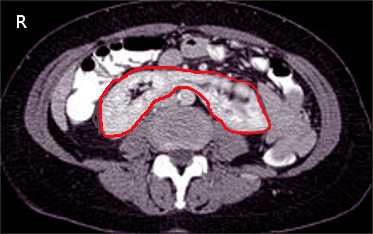[1]
Schiappacasse G,Aguirre J,Soffia P,Silva CS,Zilleruelo N, CT findings of the main pathological conditions associated with horseshoe kidneys. The British journal of radiology. 2015 Jan;
[PubMed PMID: 25375751]
[2]
Natsis K,Piagkou M,Skotsimara A,Protogerou V,Tsitouridis I,Skandalakis P, Horseshoe kidney: a review of anatomy and pathology. Surgical and radiologic anatomy : SRA. 2014 Aug
[PubMed PMID: 24178305]
[3]
Cook WA,Stephens FD, Fused kidneys: morphologic study and theory of embryogenesis. Birth defects original article series. 1977
[PubMed PMID: 588702]
[4]
Glodny B,Petersen J,Hofmann KJ,Schenk C,Herwig R,Trieb T,Koppelstaetter C,Steingruber I,Rehder P, Kidney fusion anomalies revisited: clinical and radiological analysis of 209 cases of crossed fused ectopia and horseshoe kidney. BJU international. 2009 Jan
[PubMed PMID: 18710445]
Level 3 (low-level) evidence
[5]
Stroosma OB,Scheltinga MR,Stubenitsky BM,Kootstra G, Horseshoe kidney transplantation: an overview. Clinical transplantation. 2000 Dec
[PubMed PMID: 11127302]
Level 3 (low-level) evidence
[6]
Crawford ES,Coselli JS,Safi HJ,Martin TD,Pool JL, The impact of renal fusion and ectopia on aortic surgery. Journal of vascular surgery. 1988 Oct
[PubMed PMID: 3172375]
[7]
Khougali HS,Alawad OAMA,Farkas N,Ahmed MMM,Abuagla AM, Bilateral pelvic kidneys with upper pole fusion and malrotation: a case report and review of the literature. Journal of medical case reports. 2021 Apr 5
[PubMed PMID: 33814014]
Level 3 (low-level) evidence
[11]
Mandell GA,Maloney K,Sherman NH,Filmer B, The renal axes in spina bifida: issues of confusion and fusion. Abdominal imaging. 1996 Nov-Dec
[PubMed PMID: 8875880]
[14]
Bhattarai B,Kulkarni AH,Rao ST,Mairpadi A, Anesthetic consideration in downs syndrome--a review. Nepal Medical College journal : NMCJ. 2008 Sep
[PubMed PMID: 19253867]
[15]
Cascio S,Sweeney B,Granata C,Piaggio G,Jasonni V,Puri P, Vesicoureteral reflux and ureteropelvic junction obstruction in children with horseshoe kidney: treatment and outcome. The Journal of urology. 2002 Jun
[PubMed PMID: 11992090]
[16]
Lallas CD,Pak RW,Pagnani C,Hubosky SG,Yanke BV,Keeley FX,Bagley DH, The minimally invasive management of ureteropelvic junction obstruction in horseshoe kidneys. World journal of urology. 2011 Feb
[PubMed PMID: 20204377]
[18]
O'Hara PJ,Hakaim AG,Hertzer NR,Krajewski LP,Cox GS,Beven EG, Surgical management of aortic aneurysm and coexistent horseshoe kidney: review of a 31-year experience. Journal of vascular surgery. 1993 May
[PubMed PMID: 8487363]
[19]
O'Brien J,Buckley O,Doody O,Ward E,Persaud T,Torreggiani W, Imaging of horseshoe kidneys and their complications. Journal of medical imaging and radiation oncology. 2008 Jun
[PubMed PMID: 18477115]
[20]
Lee CT,Hilton S,Russo P, Renal mass within a horseshoe kidney: preoperative evaluation with three-dimensional helical computed tomography. Urology. 2001 Jan
[PubMed PMID: 11164171]
[21]
Stein RJ,Desai MM, Management of urolithiasis in the congenitally abnormal kidney (horseshoe and ectopic). Current opinion in urology. 2007 Mar
[PubMed PMID: 17285023]
Level 3 (low-level) evidence
[22]
Rais-Bahrami S,Friedlander JI,Duty BD,Okeke Z,Smith AD, Difficulties with access in percutaneous renal surgery. Therapeutic advances in urology. 2011 Apr
[PubMed PMID: 21869906]
Level 3 (low-level) evidence
[23]
Sadiq AS,Atallah W,Khusid J,Gupta M, The Surgical Technique of Mini Percutaneous Nephrolithotomy. Journal of endourology. 2021 Sep;
[PubMed PMID: 34499550]
[24]
Skoog SJ,Reed MD,Gaudier FA Jr,Dunn NP, The posterolateral and the retrorenal colon: implication in percutaneous stone extraction. The Journal of urology. 1985 Jul
[PubMed PMID: 4009801]
[25]
Al Muzrakchi A,Aker LJA,Barah A,Alsherbini A,Omar A, Alternating Biplanar Fluoroscopy in Percutaneous Nephrostomy to Approach Stones in Patients With Horseshoe Kidney: An Institutional Experience. Cureus. 2021 Jul;
[PubMed PMID: 34430150]
[26]
Quintana Álvarez R,Herranz Amo F,Bueno Chomón G,Subirá Ríos D,Bataller Monfort V,Hernández Cavieres J,Hernández Fernández C, Surgical management of horseshoe kidney tumors. Literature review and analysis of two cases. Actas urologicas espanolas. 2021 Sep
[PubMed PMID: 34326031]
Level 3 (low-level) evidence
[27]
Quintana Álvarez R,Herranz Amo F,Bueno Chomón G,Subirá Ríos D,Bataller Monfort V,Hernández Cavieres J,Hernández Fernández C, Surgical management of horseshoe kidney tumors. Literature review and analysis of two cases. Actas urologicas espanolas. 2021 Sep
[PubMed PMID: 33958222]
Level 3 (low-level) evidence
[28]
Campi R,Sessa F,Rivetti A,Pecoraro A,Barzaghi P,Morselli S,Polverino P,Nicoletti R,Li Marzi V,Spatafora P,Sebastianelli A,Gacci M,Vignolini G,Serni S, Case Report: Optimizing Pre- and Intraoperative Planning With Hyperaccuracy Three-Dimensional Virtual Models for a Challenging Case of Robotic Partial Nephrectomy for Two Complex Renal Masses in a Horseshoe Kidney. Frontiers in surgery. 2021;
[PubMed PMID: 34136528]
Level 3 (low-level) evidence
[29]
Sobrinho ULGP,Albero JRP,Becalli MLP,Sampaio FJB,Favorito LA, Three-dimensional printing models of horseshoe kidney and duplicated pelvicalyceal collecting system for flexible ureteroscopy training: a pilot study. International braz j urol : official journal of the Brazilian Society of Urology. 2021 Jul-Aug;
[PubMed PMID: 33848082]
Level 3 (low-level) evidence
[31]
Neville H,Ritchey ML,Shamberger RC,Haase G,Perlman S,Yoshioka T, The occurrence of Wilms tumor in horseshoe kidneys: a report from the National Wilms Tumor Study Group (NWTSG). Journal of pediatric surgery. 2002 Aug
[PubMed PMID: 12149688]
[32]
Rubio Briones J,Regalado Pareja R,Sánchez Martín F,Chéchile Toniolo G,Huguet Pérez J,Villavicencio Mavrich H, Incidence of tumoural pathology in horseshoe kidneys. European urology. 1998
[PubMed PMID: 9519360]
[33]
Huang EY,Mascarenhas L,Mahour GH, Wilms' tumor and horseshoe kidneys: a case report and review of the literature. Journal of pediatric surgery. 2004 Feb
[PubMed PMID: 14966742]
Level 3 (low-level) evidence
[34]
Kölln CP,Boatman DL,Schmidt JD,Flocks RH, Horseshoe kidney: a review of 105 patients. The Journal of urology. 1972 Feb
[PubMed PMID: 5061443]
[36]
Pawar AS,Thongprayoon C,Cheungpasitporn W,Sakhuja A,Mao MA,Erickson SB, Incidence and characteristics of kidney stones in patients with horseshoe kidney: A systematic review and meta-analysis. Urology annals. 2018 Jan-Mar
[PubMed PMID: 29416282]
Level 1 (high-level) evidence
[37]
Chopra P,St-Vil D,Yazbeck S, Blunt renal trauma-blessing in disguise? Journal of pediatric surgery. 2002 May
[PubMed PMID: 11987100]
[38]
Boatman DL,Kölln CP,Flocks RH, Congenital anomalies associated with horseshoe kidney. The Journal of urology. 1972 Feb
[PubMed PMID: 5061444]
[39]
Kumata H,Takayama T,Asami K,Haga I, Living-Donor Kidney Transplantation With Laparoscopic Nephrectomy From a Donor With Horseshoe Kidney: A Case Report. Transplantation proceedings. 2021 May
[PubMed PMID: 33892929]
Level 3 (low-level) evidence
[40]
De Pablos-Rodríguez P,Suárez JF,Riera Canals L,Sanz-Serra P,Vigués F, Horseshoe kidney splitting technique for transplantation. Urology case reports. 2021 Jul;
[PubMed PMID: 33665125]
Level 3 (low-level) evidence
